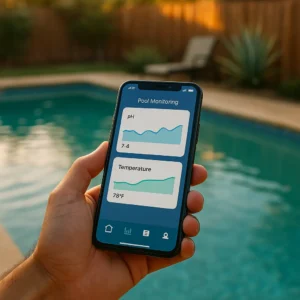Smart Water Monitoring Systems are changing how Texans care for their pools—imagine sipping lemonade poolside while your phone pings with a simple chemical alert. No guesswork. Just clear, safe water.
 Why You’ll Love Smart Water Monitoring Systems
Why You’ll Love Smart Water Monitoring Systems
Last summer, I remember crouching by my pool at sunset, stirring a fragrant breeze and worrying about pH levels. Now? My Flipr sensor floats quietly, and my phone buzzes if it senses trouble. It’s like having an assistant who never dozes off.
- Real-time balance: sensors track pH, chlorine, temperature
- Instant alerts via app: no waiting for strips to dry or chemicals to settle
- Proactive maintenance: fix issues before they spiral
How It Works
What the Sensor Does
It’s a small device that floats or mounts in your pool and checks water chemistry every few hours—kind of like a tiny scientist swimming around, sniffing the water.
Why It’s Better
No more splatter of testing strips or blurry evenings adjusting pH by feel. You get numbers, charts, even patterns over time. It’s precise, yet simple.
Features That Matter
- Continuous monitoring – unlike weekly check-ins, sensors run 24/7
- Historical data – track puzzled swings during heatwaves
- App control – whether poolside or beachside, you’re connected
- Compatibility – many integrate with smart home systems (Alexa, Google)
This is where convenience meets confidence—you’ll know exactly when to add chlorine or raise alkalinity.
Benefits in the Texas Heat
- High temperatures speed up chemical reactions—smart sensors detect shifts fastç
- Dust and pollen storms hit hard—filters tell you when to act
- If you’re hosting a party, quick-chemical checks keep everything safe
What to Choose: Top Models
Flipr Uno – easy plug-and-play floating sensor
pHin Smart Water Monitor – subscription service with guided dosing
SALT PRO Smart Sensor – integrates with saltwater pools
Tips for Best Results
- Keep sensor clean—rinse weekly
- Follow weekly app suggestions
- Compare trends (temp vs pH)
- Sync with your cleaning scheduler
 One Simple Bullet List
One Simple Bullet List
- Proactive alerts
- 24/7 live data
- Lower chemical waste
- Avoid expensive fixes
Making It Work for You
If you’ve struggled with yellow water, itchy skin, or weekend chemical dosing—this tech eases all that. Plus, save time (more evenings by the grill) and money (no guesswork purchases).
Smart Water Monitoring Systems are more than gadgets—they’re peace of mind in Texas summers. You’ll keep your pool balanced and inviting, with less time testing and more time enjoying.
Oh, and if you’re curious about automating all this, check out our other article on “Robotic Pool Cleaners in Texas: Are They Worth It?” You’ll see how sensors and robots can team up for a fully hands-off summer.
FAQ
1. What does a smart water monitor measure?
It typically tracks pH, chlorine (ORP), temperature, and sometimes alkalinity—giving live data through an app.
2. How accurate are these devices?
Very—within ±0.1 pH or ±0.1 ppm chlorine. Better than test strips and much more convenient.
3. Do they work for saltwater pools?
Yes—many models, like the SALT PRO or pHin, support salt systems natively or via add-ons.
4. Can I rely solely on the app alerts?
Mostly, yes—but occasional manual tests are a good idea to ensure calibration.
5. Are they hard to install?
Not at all. Most float or clip on, and pairing with your phone takes just a few minutes.
